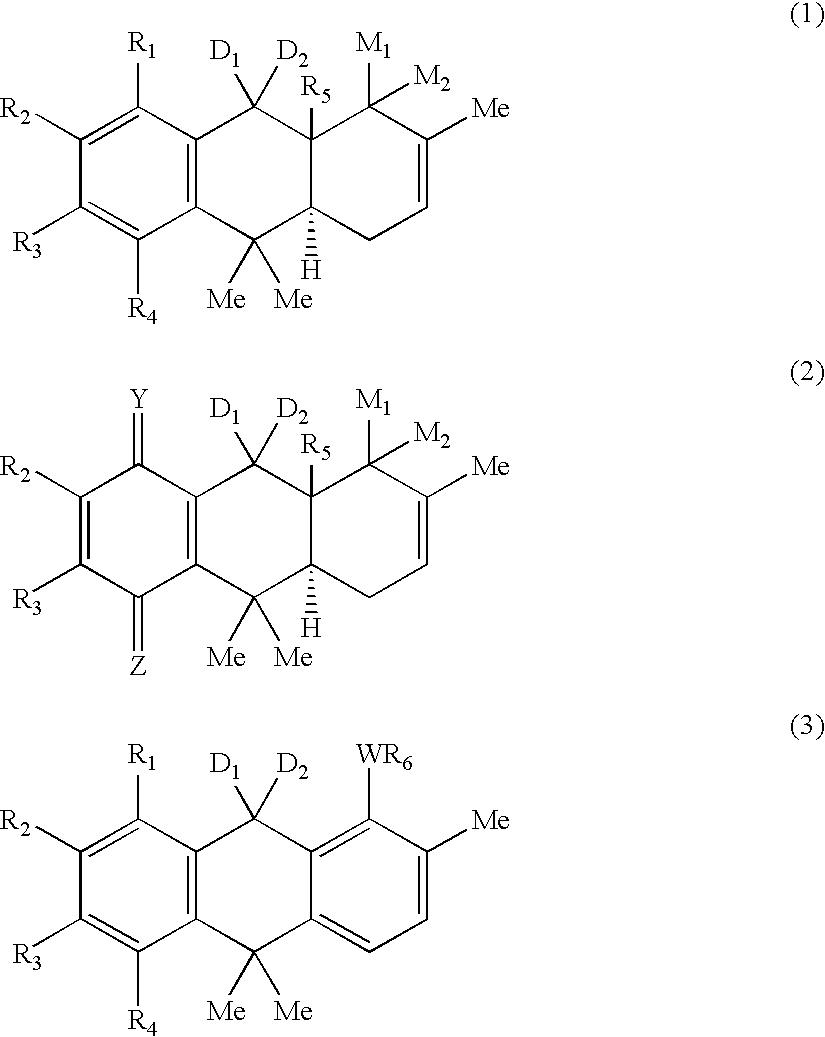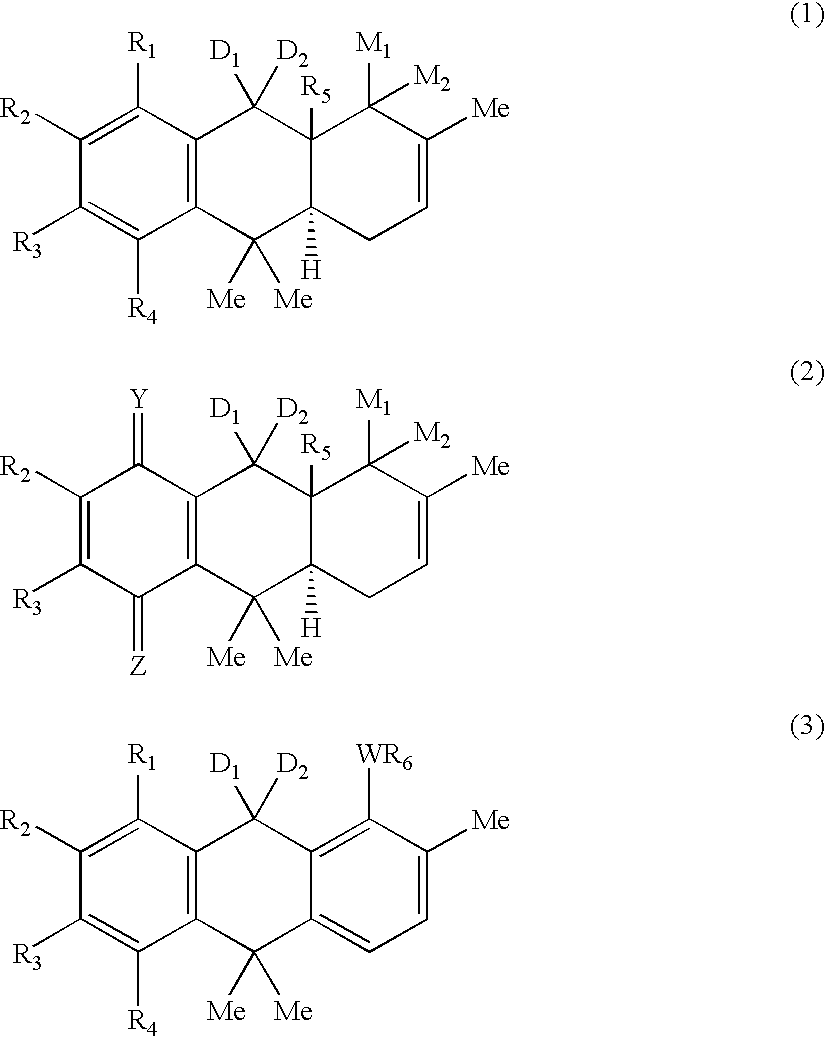Hydroanthracene based compounds as anticancer agents
a technology of anthracene and compound, applied in the field of hydroanthracene based compounds, can solve the problems of intercalation of dna base pairs, significant toxic side effects, and inability to detect dna, and interfere in the cell transcription and replication process
- Summary
- Abstract
- Description
- Claims
- Application Information
AI Technical Summary
Benefits of technology
Problems solved by technology
Method used
Image
Examples
example 1
Preparation of Compound of Formula (31)
[0129]To a stirred solution of LDA, prepared from diisopropylamine (3.44 g, 4.76 ml, 34 mmol) and n-BuLi (2.09 g, 16.3 ml of 2 M solution in hexanes, 32 mmol) in THF (30 ml) at −10° C. for 1 h, was added (R)-(−)-carvone (30) (3.78 g, 4 ml, 25 mmol) in dry THF (40 ml) drop-wise over 1 h at the same temperature under nitrogen atmosphere. The stirring was continued for further 2 h. At this temperature was added drop wise a solution of 2,5-dimethoxybenzylbromide (7.52 g, 32.5 mmol) in dry THF (20 ml) during 10 minutes. The reaction mixture was further stirred at −10° C. for 3 h and then the temperature was warmed to room temperature over 1.5 h and stirred for 14 h to complete the reaction (TLC monitored). The reaction mixture was quenched with saturated NH4Cl solution. The organic layer was separated and THF removed under reduced pressure in rotary evaporator to leave oil. The aqueous part was extracted with ether (200 ml) and the ether layer was c...
example 2
Preparation of Compound of Formula (16)
[0132]A solution of compound of formula (31) (1 g, 3.3 mmol) in MeSO3H—P2O5 (10:1) mixture (10 ml) was stirred at 5° C. (ice cold bath) for 1 h 30 minutes to complete the reaction (TLC monitored) under nitrogen atmosphere. The reaction mixture was carefully quenched with crushed ice and extracted with ether (100 ml). Ether layer was washed with NaHCO3, water, brine and dried over anhydrous Na2SO4. Solvent was evaporated to leave oil. The crude oil was chromatographed over silica gel (60-120 mesh, 3 to 5% EtOAc in petroleum ether as eluent) to afford the cyclized product (16) (856 mg, 85.6%) as a white solid.
[0133]m.p.: 120° C.
[0134]IR (KBr): ν 2938.98, 1665.23, 1593.88, 1469.49, 1365.35, 1255.43, 1058.73, 805.13, 720.28 cm−1.
[0135]1H NMR (CDCl3, 300 MHz): δ 1.29, 1.35 (3H, s, the two isomers present could be identified in this case in the ratio of 3:1 as seen from the NMR signals), 1.47, 1.50 (3H, s, the two isomers present could be identified ...
example 3
Preparation of Compounds of Formula (4)
[0136]To a stirred suspension of ceric chloride (215 mg, 0.575 mmol) and compound of formula (16) (115 mg, 0.383 mmol) in dry methanol (15 ml) was added at −40° C. under nitrogen atmosphere NaBH4 (51 mg, 1.34 mmol) portion wise. The reaction mixture was stirred for 1 h at −40° C. and then at room temperature for 3 h. Dilute acetic acid was added carefully at 0° C. to destroy excess borohydride. Methanol was removed in a rotary evaporator and the residue dissolved in ether. The ether layer was washed with saturated NaHCO3 solution, water, brine, dried with anhydrous Na2SO4 and the solvent was evaporated to give the crude product. The crude product was chromatographed over silica gel (60-120 mesh) to give unsaturated alcohol (4) (6% EtOAc in petroleum ether as eluent) as a white solid (95 mg, 82%).
[0137]m.p.: 110-112° C. (mixture of stereoisomers).
[0138]IR (KBr): ν 3404, 2936, 1459, 1437, 1253, 1060 cm−1.
[0139]1H NMR (CDCl3, 300 MHz, Three major ...
PUM
| Property | Measurement | Unit |
|---|---|---|
| temperature | aaaaa | aaaaa |
| temperature | aaaaa | aaaaa |
| temperature | aaaaa | aaaaa |
Abstract
Description
Claims
Application Information
 Login to View More
Login to View More - R&D
- Intellectual Property
- Life Sciences
- Materials
- Tech Scout
- Unparalleled Data Quality
- Higher Quality Content
- 60% Fewer Hallucinations
Browse by: Latest US Patents, China's latest patents, Technical Efficacy Thesaurus, Application Domain, Technology Topic, Popular Technical Reports.
© 2025 PatSnap. All rights reserved.Legal|Privacy policy|Modern Slavery Act Transparency Statement|Sitemap|About US| Contact US: help@patsnap.com



